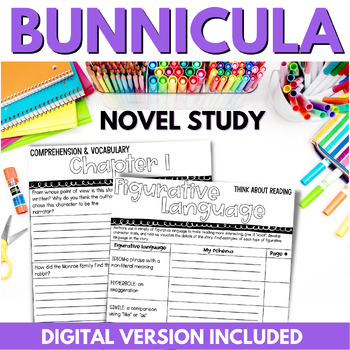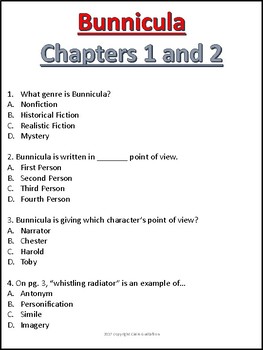Bunnicula Discussion Guide
- Deborah & James Howe. A Novel Study by Joel Michel Reed. Be expected to provide clear answers to questions and well-constructed.
- Comprehension questions and answers on pages that are approximately the same as those used in creating this study guide. And the answers to the.
Bunnicula By Deborah and James Howe Synopsis Bunnicula: A Rabbit-Tale of Mystery is a 1979 children's novel by Deborah and James Howe, the first in his Bunnicula series. Based on a 2007 online poll, the National Education Association named the book one of its 'Teachers' Top 100 Books for Children.'
Bunnicula Novel Unit is a Common Core Standard aligned book study to be used with Bunnicula by Deborah and James Howe. This download contains both a printable format as well as a Google Drive™ compatible format. This is a complete novel study that includes many individual products bundled together to offer you extensive savings! This comprehensive unit also includes Google Drive™ format files, additional writing activities, teacher plans, and CCSS alignment that you cannot find in the individual components. This complete novel study is by far your best value! This unit is designed to be used with some student/instructor interaction, but can easily be used as an independent study for the student.
It is written for the 3-5th grade reading level. This unit works great in a one-on-one setting for homeschool or for a teacher to use as a resource in the classroom for a small group or entire class. The unit is designed so that you can start teaching immediately with little to no preparation on your part.
Great time saver!. This unit contains: Teacher Packet containing:.Detailed daily lesson plans.Pacing & Standards Guide.Answer keys Student Packet (both printable and Google Drive™ format) containing:.Vocabulary activities for 19 words.Comprehension questions in a short answer format for deeper thinking for every chapter.Extension activities that correlate with the book.Only available in this complete Novel Study Product! An Assessment Packet (both printable and self-grading Google Drive™ format) that contains:.An after the book vocabulary quiz.An after the book comprehension quiz in both a short answer and multiple choice format.An after the book writing assessment.Google Drive Self-grading quizzes are only available in multiple choice formats. An End of the Book Activity Packet that can be used with any book. A Story Elements Interactive Notebook Activity Packet (both printable and Google Drive™ format) that can be used with any book. Common Core Standards Alignment for Grades 3-5. This is included at the end of the unit so if you do not need it you can easily discard without changing the unit itself.
To see how this is set up please see the free preview for the CCSS checklist in its entirety. You can find this product here.
Enrichment Activities. A PET'S STORY. 'My Life With Humans' The animals in Bunnicula have human characteristics. They can think and talk and read! Imagine that your pet could talk. Create a story about your family from your pet's point of view. First, think about some of the interesting things your family does that would make your story funny.
If you have more than one pet, you could have your pets talk to each other in dialogue. If you don't have a pet, let one of your dolls or stuffed animals tell a story about your family. Remember to have your pet describe you!

Use a graphic organizer to help you think about each member of the family your pet will describe. Include their age, what they look like, their likes and dislikes, personality traits, good and bad habits and something about how the human relates to the pet telling the story (examples: 'She never feeds me,' 'He calls me a fleabag'). Hint: Use a graphic organizer for this activity. A dog or cat in the center with thinking bubbles for the child to write about each family member will help the students be organized in their writing. IT'S ALL IN A NAME Bunnicula's name was created by combining 'Bunny' and 'Dracula.'
Combine some other animal names and monsters to create your own weird creature. Illustrate your monster and then build your monster out of craft materials, junk, boxes, bags, etc. Be sure that both parts of the name are represented. Materials: Construction paper, art materials, aluminum foil, paper grocery bags, large boxes, paper-towel rolls, assorted recycled materials.

MYSTERY NIGHT Be a Super Sleuth! Create your own mystery, complete with characters, crime, and clues! Act it out for another group, so they can try solving your mystery.
Bunnicula Book Review
To get started, parents or teachers might write a scene on a 3x5 card. Then a team could create the skit from the suggestion (this would avoid a mystery with violence.) You might read a partial story to the teams and have each one write different endings or solutions to the mystery.
Chris Van Allsburg's book, The Mysteries of Harris Burdick, has great story-starters. PUZZLE IT OUT Create your own fun night! Bring games and puzzles that require problem solving. Set up stations and set your Junior Sleuths to work. You might include 'Clue,' an oldie but goodie. You might have kids brainstorm lots of words that have to do with mysteries, then put them into a word search (crime, detective, clue, investigation, etc.) Bring all kinds of puzzles: jigsaw, 3-D, word puzzles, and manipulative puzzles.
DRACULA – Fact or Fiction? Provide resources for research to find out about Dracula.
Was he a real person? How much of the legend is fact or fiction?. USE YOUR SENSES Here's an idea to help the Junior Sleuths use their senses for investigation. Collect a variety of substances to smell in small jars or ziplock bags. Number each bag. Give the kids a sheet of paper with the numbers on it and a blank next to each number. As they sniff each bag, have them identify the substance (cinnamon, pepper, soap, crayons).
They should not be able to see the substance, so blindfold the kids or cover the containers with paper. Next, test their sense of taste – and be sure all the items you use are edible! Check beforehand for allergies to peanut butter or any other food products (chocolate, peanut butter, fluff, jello, fruit, etc.) Put items in little containers and use a plastic spoon as each item is tested.
Again, the students need to be blindfolded! Then, the sense of touch. Put a variety of items in individual bags.
Label the bags with numbers. Kids reach in and feel each item. Be creative, but avoid sharp edges. (Suggestions: calculator, paperclip, rubber ducky) Record some sounds around the house and see if the kids can detect what they hear. (Suggestions: running water, the clothes dryer, someone typing on the computer, electric hair dryer) You can elaborate on this activity according to your particular group. You might also test their powers of observation by asking an adult to enter your classroom who is wearing something that is not quite right or normal.
Convert documents to beautiful publications and share them worldwide. Title: 1986-1989 Honda TRX350 Fourtrax TRX350D Foreman Service Repair Manual. Instant download of a repair manual for the 1986-1987 Honda FourTrax 350 and 1987-1989 Honda TRX350D Foreman atvs. Covers complete tear down. 5 days ago - 350 Foreman 350D TRX350 TRX350D TRX service manual repair 1986. VIEW DETAILS Honda 1986 1989 Fourtrax Foreman 350 service. Also for: Trx350 fourtrax 1987, Trx350d foreman 1988, Trx350d foreman 1987, Trx350d foreman 1989. Related Manuals for Honda TRX350 FOURTRAX 1986. 1986-1989 Fourtrax/Foreman 350 Service Manual. I had searched prior to buying a 1988 TRX350D and when I got home, I had my debit. 1986 1989 honda fourtrax 350 foreman 350d service manual.
After the person leaves the room, see if the students noticed what was different about the visitor's clothing (suggestions: mismatched earrings, mismatched socks, something buttoned the wrong way). See if the kids can recall what the person was wearing that was different. You can also move something in the classroom and then ask the students if they know what's different in the room. Prev. 1.